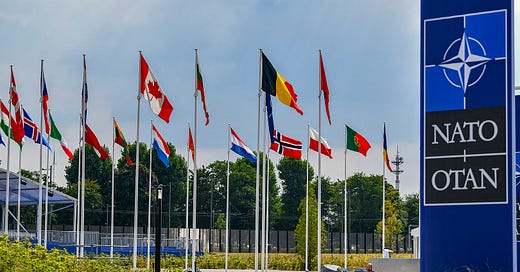Ukrainian President Volodymyr Zelensky has called for NATO to implement a no-fly zone over Ukraine. This has the potential to save a lot of Ukrainian lives and to benefit Ukrainian forces. But it would also probably entail directly confronting Russian military forces and would be tantamount to entering the war against Russia. It would significantly increase the chance of a potentially catastrophic nuclear war between NATO and Russia.
A no-fly zone over Ukraine would help Ukraine. NATO air forces probably have the capability to achieve air superiority and enforce a no-fly zone over Ukraine. It could save a lot of Ukrainian lives. It’s heartbreaking to know we could do something to help Ukrainians and aren’t doing it. Ukrainian President Volodymyr Zelensky has demanded that NATO close the skies over Ukraine, telling NATO that, if it doesn’t, “all the people who die from this day forward will also die because of you, because of your weakness, because of your disunity.”
But you can’t create a no-fly zone simply by flicking a switch. Enforcing a no-fly zone means threatening to and potentially shooting down any aircraft that violate the zone. There isn’t any clear dividing line between air and ground combat—aircraft and ground forces can shoot at one another—so it might also require engaging forces on the ground that threaten aircraft enforcing the no-fly zone. It would therefore probably mean directly engaging Russian forces. It doesn’t matter whether you call it a “humanitarian no-fly zone” or simply intend to protect civilians. A no-fly zone would primarily benefit the Ukrainian side—which doesn’t have the air power Russia does—so Russia is unlikely to see it as a humanitarian mission. What Zelensky is asking is essentially for NATO to enter the war against Russia.


That would clearly increase the immediate risk of nuclear war. We don’t have a large “comparison class” of similar situations to compare the situation in Ukraine to, so it’s hard to say with certainty exactly how great the risk is. In the past no-fly zones have been implemented in conflicts in which opposing forces didn’t have much capability to retaliate. In this case, Putin can certainly retaliate, and seemed to suggest Russia would use nuclear weapons against any country that interfered with Russia’s invasion. The background risk of nuclear weapons being used in times of relative peace is not high, but it is also not vanishingly small. Good Judgment superforecasters—including me—estimated a few years ago that the chance of a nuclear weapon being used on human targets was about 0.4% a year.1
Russia’s invasion of a democracy on NATO’s border has likely already increased that risk dramatically. Last week I estimated there is a 4% chance Russia will use a nuclear weapon before July. Enforcing a no-fly zone over Ukraine—which, again, would require driving Russian aircraft from the skies—would increase the risk further. It would increase both the risk that Russia would deliberately escalate further in retaliation and the risk that an accident or miscalculation leads to a broader war. Worse, it would particularly increase the risk of nuclear war between NATO and Russia—and as a consequence increase the risk of a nuclear exchange severe enough to threaten the survival of human civilization.

I don’t want to exaggerate the risk. I’m not saying a no-fly zone would definitely lead to nuclear war between NATO and Russia. I think it probably wouldn’t. But the chance that it could lead to an actual exchange of nuclear weapons in the near term would rise significantly. The exact risk of a nuclear exchange would probably depend on how a no-fly zone was implemented, but it might be on the order of a few percent. A single nuclear nuclear weapon used against a large city could by itself cause suffering on a scale similar to the invasion of Ukraine. A broader exchange of nuclear weapons would be a tragedy on a scale that would dwarf even the already terrible human cost of Russia’s invasion. In most circumstances—even when a lot is on the line—the only reasonable choice is to keep the risk of a nuclear war very low. Zelensky is right when he says we’ll bear responsibility for deaths that result from the decisions we make now.
Forecasting the Russian Invasion
In the days leading up to the Russian invasion of Ukraine, the best forecasters I know were sharply split as to whether Russia would actually invade. Some of the most accurate Good Judgment supers thought an invasion was likely as far back as December or January. Others—including last year’s most accurate forecaster—thought an invasion was unlikely almost up until the day it actually happened. One reason our aggregate forecast was volatile was that many of us were trying to weigh the evidence of military mobilization against the idea that an invasion would be a disaster for Russia. In a recent Good Judgment “post-mortem” analysis, one super put it this way: “Some people focused on the logic of it. Some focused on the facts of it. There was a huge gap between those two groups. Those focused on ‘it doesn’t make sense to me’ could not be persuaded.”
There is a term in intelligence analysis for the danger of focusing on the logic of a situation: “mirror imaging”. When you assume that other actors will see things the way you do—that they are, in some sense, your mirror image—you can unconsciously impose your own perspective onto the thinking of others. That said, it’s still generally useful in forecasting to assume that actors will act in a way that broadly “makes sense.” The lesson I take from trying to forecast the invasion of Ukraine is not that I shouldn’t try to put myself into other actors’ heads, but to question my assumptions about what might make sense them—and always to pay careful attention to what they’re actually doing.




